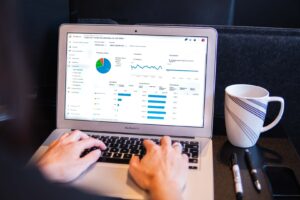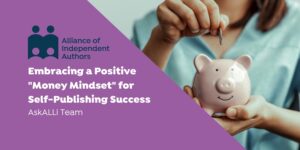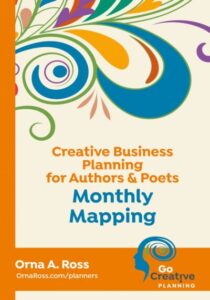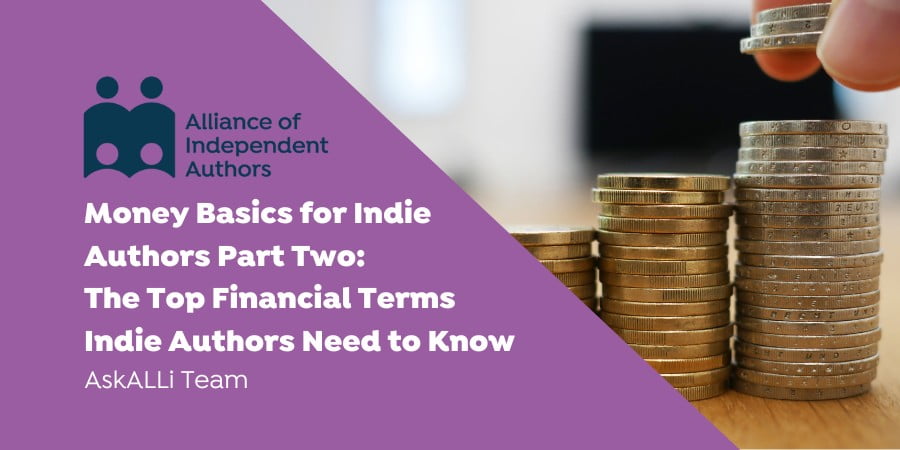
Photo by Siora Photography on Unsplash
Can money matters put your head in a spin? Here at the Alliance of Independent Authors we believe a positive approach to managing your money can make all the difference in your author career. And to build that positive outlook, you also need to build your confidence. With this post you can do just that, by picking up the top financial terms indie authors need to know.
We’ve brought together some key words and phrases, from A to T, explaining them in simple terms to provide a quick reference for all indie authors, with a focus on those of us just setting out on an author career. So take a look and bookmark this page for future reference.
1. Accountant
Accountants (officially known as Financial Accountants, Chartered Accountants (CA) or Certified Public Accountants (CPAs)) aren't just for big businesses. Particularly if you are working full or part time alongside your writing, investing in the time of an accountant can take the sting out of financial management. They can help you keep track of the money you spend (including your author-related expenses) and the money you make. And, perhaps most importantly, they can help with your annual tax returns. If you decide to take on an accountant, you might want to choose one located close to you, take a recommendation from a writing contact, or investigate virtual accountancy support which can be more cost effective.
Generally the national financial accounting institution for your nation will have a list of their certified members. It is always advisable to check with their database that the accountant is registered. A few resources to find accountants are:
- England & Wales: ICAEW Find a Chartered Accountant
- Scotland: ICAS Find a Chartered Accountant
- US: CPA Validate a Chartered Accountant
- Ireland: NI Chartered Accountants Directory
- Australia & NZ: Chartered Accountants Australia and NZ
2. Assets
As an author, your ‘assets' are everything you create or own in relation to your author business. So this includes your books of course, but also any software you own, any copyright licenses etc. Although note, that it doesn't cover devices you have bought, such as laptops.
3. Balance Sheet/ Statement of Financial Position
This is a sheet where all of your author business assets are listed, along with the capital (the money you hold to meet your cost or invest in future growth) and the liabilities you have committed to fund those assets. All are listed out to show the comprehensive financial situation of your business at a certain point in time. (Note, that the Profit & Loss document – see below – covers a period of time).
4. Bookkeeping
Bookkeeping simply means the actions taken to record and track all the financial transactions of your business. It often involves producing regular reports or statements to monitor the financial position of the business. If you have an accountant, they may be referred to as your “bookkeeper”.

5. Business Bank Account
Having a business bank account used only for your author business helps you easily keep a track of business-related incomings and outgoings. Keeping a clear line between your business and personal funds makes bookkeeping easier, including tax accounting. To check how much you have spent and received in relation to your author business can then be as easy as printing out your business bank account statement.
6. Cash Flow
Your cash flow is the money that goes in and out of your business to keep it running. Positive cash flow is what you are aiming for. It means your business has money available to cover ongoing expenses or unexpected costs.
7. Creator Economy
You may come across this phrase when you are financial planning. It refers to creators making their living by receiving payment directly from their audience. In other words, consumers directly funding the work of the creator. Self-publishing, as opposed to traditional publishing, sits in this market by bypassing the traditional facilitators between author and reader, such as a traditional publisher. You can find out more about the creator economy with this post from ALLi Director, Orna Ross: Indie Authors and the Creator Economy.
8. Credit Score
If you're looking to borrow money to fund your author business, a bank will run a credit check on you as the person responsible for paying back the amount borrowed. A credit check looks at your financial records from your past to give you a “score”. Your credit score can affect how much you can borrow and how much you may be charged to do so. A good credit score reflects positive money management such as having few or no other debts, and a history of paying back debts (such as credit cards) on time.
9. Expenditure
The payment of cash or credit in exchange for goods or services. You will incur expenditures during your author career, and these should be recorded in your financial records.
 10. Financial Plan
10. Financial Plan
A financial plan should be written at the beginning of each year at a minimum, and sets out your goals and actions regarding finance. It may form one part of your wider business plan. At a minimum it should include your anticipated income, spending, debt repayments (if you have any) and your short- and medium-term financial goals. But you can also include your long-term goals too, such as where you want your author business to be financially in three or five years. This document helps you plan ahead, keep focused on your finances, and identify what you need to do when to hit your goals.
11. Gross Profit
This is the term used to describe the amount received from selling your books, and other related products, after taking away the costs associated with producing them (typically editing, cover design, illustrations etc). It is often better to look at your Net Profit (see below) to get a better understanding of the actual money you will ‘take home’ from the sale of your books or related products.
12. Income Streams
This describes all the different ways you make money in your career. Some authors will have a range of income streams, from teaching to editing to podcasting; all running alongside their author role. Spreading your income across different income streams can ensure you have financial support even if you have a quiet period of sales from your books. But highs and lows are true of everyone in every business and are not something to be afraid of… if you are prepared. For more on your options for widening your income streams, take a look at this post: Multiple Streams of Income.
13. Invoices
An invoice is an official document that records a transaction between a buyer and a seller. It will include itemized details of what has been bought, whether it is an item or your time, with a total cost (like a bill in a restaurant). An invoice should be dated, and include the suppliers name, contact details and payment terms (i.e. “Payment is required within 30 days of invoice received”). If you are invoicing others, a template that you can use for each invoice can save time when producing regular paperwork.
14. Liabilities
Liabilities are what you are committed to paying to other parties, such as payments on a bank loan, wages, or money due to suppliers either now or committed to be paid later.
15. Net Profit
Net profit is the amount of money your business makes after deducting all operating, interest, and tax expenses over a given period of time. To find this value, take your gross profit and take away all other costs you have incurred throughout the time period, including any tax payments. Net profit is also often referred to as a company's “bottom line” and is a clearer indicator of profitability.
It is important to note that your net profit figure will not match the cash flow amount, in most cases. This is because it also includes depreciation and other pro rated expenses the accountant will deduct to arrive at the net profit. These deductions depend on each country's rules and an accountant will be able to explain what relates to you. But net profit is important, because this figure is what is used (‘net profit before taxes') to calculate the taxes you owe.
16. Profit & Loss (P&L) Statement
This financial document summarizes your author business’s income and expenses over a period of time. It is usually created and updated before you produce your balance sheet at the end of a time period to find your net profit. The detail included in a P&L makes it useful for checking against the previous year's budget to spot any variances. An example P&L can be found here: Investopedia Example P&L Statement.
17. Profit Margin

Photo by Myriam Jessier on Unsplash
Profit margin is a measure of profitability that’s calculated by dividing the overall net income you have made by the total number of sales you have made. This then works out how much money in real terms you make per book sale.
18. Purchase Order (PO)
A purchase order, or “PO”, is a legally binding document created by a buyer and given to a seller. It should be given ahead of the supply of an item or work. It includes what has been ordered and a breakdown of the costs, as well as a “Purchase Order Number” (or PO Number). This number is then be used to discuss or track the order. When someone submits a Purchase Order, the buyer is officially committing to purchasing goods or services for the agreed amount.
19. Return on Investment (ROI)
Return on Investment (ROI) is a simple sum used to work out the expected money you will make by undertaking a project or activity in comparison to the cost of the investment. This measure is often used to evaluate whether a project will be worthwhile financially. ROI is calculated using the following equation to produce a percentage: ROI = [(Income – Cost) / Cost] * 100.
20. Royalty Payment
In traditional publishing, the royalty payment is the percentage of the sale price of each book an author receives after the publisher has taken their cut (and after an advance has been covered). Although not exactly the same, ‘royalty payment' in indie publishing is often used to describe the percentage of the sale price of each book a self-published author receives after paying a platform or shop commission for making the sale. If you are selling your books via a website, such as Amazon, they may use the word ‘royalty' to describe this payment, and you will need to take a look at the royalty options available when you upload and price your book.
21. Spot rate
While indie authors don't need to calculate this, this is an important number to be aware of. The spot rate is the currency exchange rate applied to a sale transaction when any retailer remits the money from a different currency to yours. For most of us that is USD to your own currency. The ‘spot rate' changes regularly and in practice there's a spot rate decided every day.
22. Tax
Find out from the outset what sort of tax you will need to pay on your author earnings and any deadlines for declaring the tax owed. This will be different in different countries. If you are in the UK, you may find you need to complete what is called a ‘self-assessment’ tax return on your net income. This can be completed yourself or with the support of an accountant. You'll need to fill in a tax return every year, so make sure you have the deadlines in your diary to complete all necessary actions in time.
What's your author business model?

Orna Ross, ALLi Director
So there you a have it, a selection of the top financial terms every indie author should know. But… your chosen business model will also impact both your financial planning and the terms you will come across. For a full low down on indie author business models, take a look at this post from ALLi Director Orna Ross: Business Models for Authors.
Here’s a quick summary of the key business models in Orna’s own words:
Exclusive Self-Publishing Model – you publish books exclusively with one self-publishing platform e.g. Amazon.
Wide Self-Publishing Model – you publish books non-exclusively with a range of self-publishing platforms and aggregators e.g. Kobo Writing Life, PublishDrive.
Creator Model – as well as publishing books through third-party self-publishing platforms, you also sell books and other products directly to readers and other customers through your own website and/or other outlets e.g. Shopify store, Kickstarter and have other income sources e.g. YouTube, Patreon, courses.
Rights Licensing Model – as well as using self-publishing platforms and/or selling direct, you earn 50+ of your income from licensing rights to third-party publishers, producers, and other rights buyers.
Publisher Model – you publish other authors' books as well as your own, for business purposes.
Find out more
Money Basics Part One: Embracing a Positive ‘Money Mindset'
 Catch up on part one of the Money Basics series with this Money Mindset post. A positive shift around money management can be daunting if you have focused solely on the writing craft for many months or years. But adopting a positive money mindset can turn what might feel like an overwhelming responsibility into an empowering opportunity.
Catch up on part one of the Money Basics series with this Money Mindset post. A positive shift around money management can be daunting if you have focused solely on the writing craft for many months or years. But adopting a positive money mindset can turn what might feel like an overwhelming responsibility into an empowering opportunity.
This post includes hints and tips to help move your mindset and take full responsibility for the financial elements of your author business: Embracing a Positive ‘Money Mindset'.
Creative Self-Publishing Resources Available from ALLi
 You've probably heard of ALLi's top indie author guide book, Creative Self-Publishing. Did you know the new third edition comes with a newly updated business planning section? You can also get an accompanying series of planners that guide authors and poets with the day-to-day of publishing. These practical planners support authors with:
You've probably heard of ALLi's top indie author guide book, Creative Self-Publishing. Did you know the new third edition comes with a newly updated business planning section? You can also get an accompanying series of planners that guide authors and poets with the day-to-day of publishing. These practical planners support authors with:
- Optimising your time management and finances with tried-and-tested success tools
- Overcoming creative blocks with mind maps, charts for creative rest and play, and writing exercises
- Replacing overwhelm and procrastination with clarity and simplicity
- Setting effective success measures to aid your happiness
The Monthly Mapping Planner in particular aims to expand your impact, influence, and income as an indie author. And the Quarterly Business Planner helps authors set ambitious but achievable targets over a three-month period. It also provides monthly work and profit planners, and lots more strategic support. Both planners are available for purchase in multiple formats on our bookstore. Members enjoy free access to the ebook versions.


 10. Financial Plan
10. Financial Plan


I really value the fact that you took the time to share the information with others. I had been doing research on a certain subject for quite some time when I came across this topic, and I realized that it was really relevant to that subject.